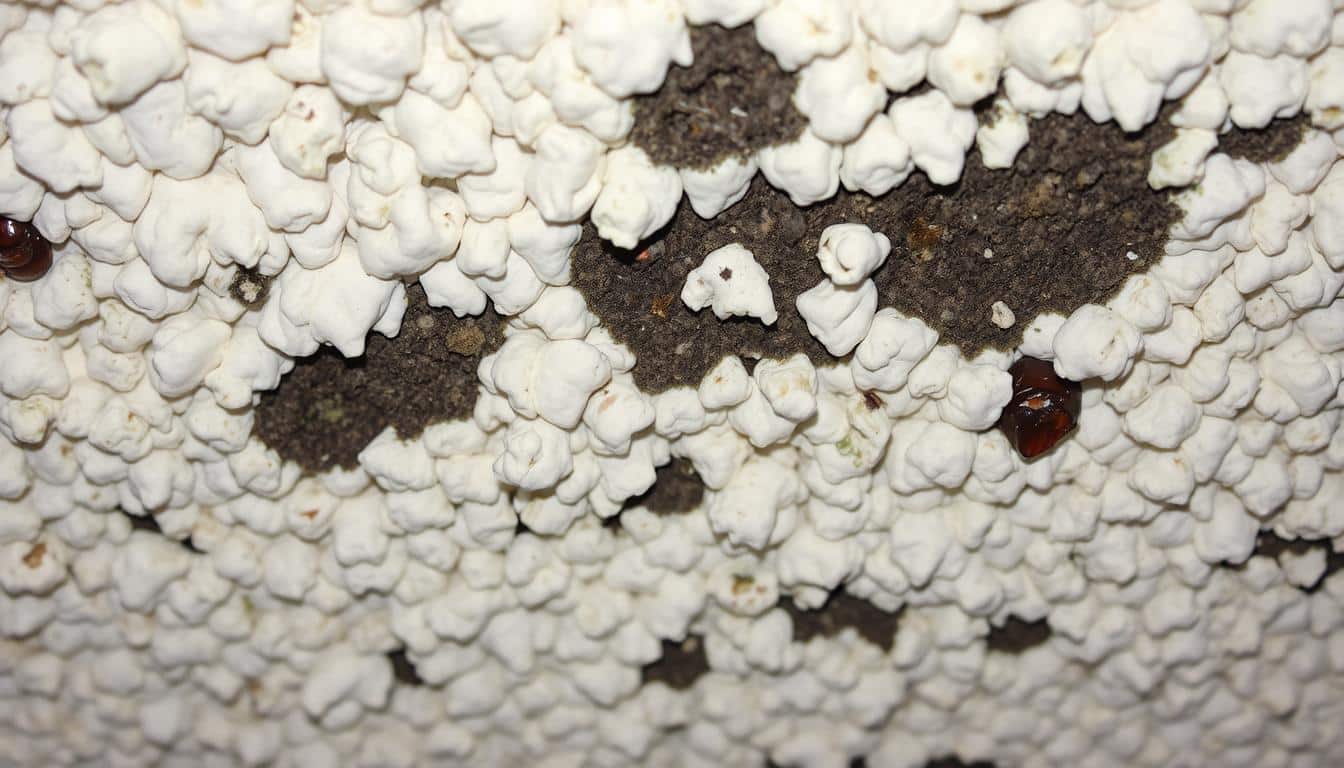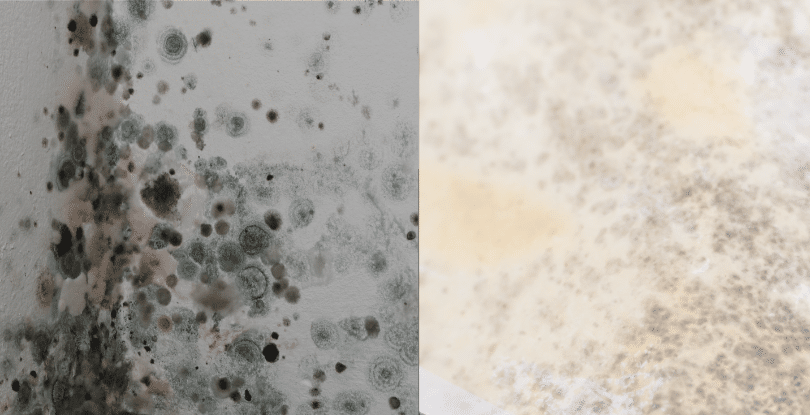Did you know that 85% of homes built before the mid-1980s might have popcorn ceilings with asbestos? Asbestos is a hazardous material that can be very dangerous. This shows how important it is to take care of these ceilings, especially when mold and mildew appear.
As a homeowner, I know how hard it can be to keep a popcorn ceiling clean. But, getting rid of mold and mildew doesn’t have to be hard. In this guide, I’ll show you how to safely and effectively remove these unwanted growths. This will make your ceiling look clean and fresh again.
Key Takeaways
- Popcorn ceilings may contain asbestos, requiring caution during cleaning to avoid health risks.
- Proper safety equipment, including a mask and goggles, is essential when cleaning popcorn ceilings.
- Mold and mildew can be removed using a variety of cleaning solutions, such as bleach, vinegar, and dish soap.
- Maintaining your popcorn ceiling with regular dusting and cleaning can help prevent the buildup of stains and microbial growth.
- Professional mold cleaning services may be necessary for extensive mold and mildew issues or if asbestos is a concern.
Introduction to Popcorn Ceilings
Popcorn ceilings, also known as “cottage cheese” or “stucco” ceilings, were popular in the mid-20th century. They were made by spraying a mix of styrofoam and stucco onto the ceiling. This created a bumpy look that helped with sound insulation and hid imperfections.
History and Characteristics of Popcorn Ceilings
These ceilings were common in homes from the 1950s to the 1970s. Now, some people like their retro look. But, they can be hard to keep clean because of their texture.
The unique texture of popcorn ceilings was made by spraying. It gave a special look and helped with sound and hiding small ceiling flaws.
But, there’s a downside. Some older popcorn ceilings might have asbestos. This has made people worry about their safety. So, some choose different ceiling options.
| Characteristic | Description |
|---|---|
| Texture | Popcorn ceilings have a distinctive, bumpy, and textured appearance created by spraying a mixture of styrofoam and stucco onto the ceiling. |
| Sound Insulation | The textured surface of popcorn ceilings helps to absorb sound, providing improved acoustic properties in a room. |
| Imperfection Concealment | The rough, uneven texture of popcorn ceilings can effectively hide minor ceiling imperfections, such as cracks or uneven surfaces. |
| Asbestos Concerns | Older popcorn ceilings may contain asbestos, which was commonly used in construction during the mid-20th century, raising safety concerns for homeowners. |
“Popcorn ceilings were a popular choice in the past, but their maintenance and potential safety issues have led many homeowners to explore alternative ceiling treatments.”
Homeowners looking into popcorn ceilings must consider their pros and cons. Knowing about popcorn ceilings helps decide if they’re right for a home.
Preparing for Cleaning Popcorn Ceilings
Safety Precautions and Supplies Needed
Before you start cleaning a popcorn ceiling, it’s key to take safety steps. If your home was built before 1978, the ceiling might have asbestos, a harmful substance. It’s important to test the ceiling and get it removed by experts if it has asbestos. After confirming it’s safe, you’ll need the right tools for a clean and safe job.
Here’s what you’ll need to clean a popcorn ceiling:
- Plastic sheets or tarps to protect your furniture and floors
- A dust mask or respirator to protect your lungs
- Safety goggles to shield your eyes
- Work gloves to protect your hands
- A vacuum with a dusting attachment or a long-handled duster
It’s vital to keep yourself and your space safe from dust and debris. With the right safety measures and tools, you’ll have a smooth cleaning process.
| Safety Precautions | Supplies Needed |
|---|---|
|
|
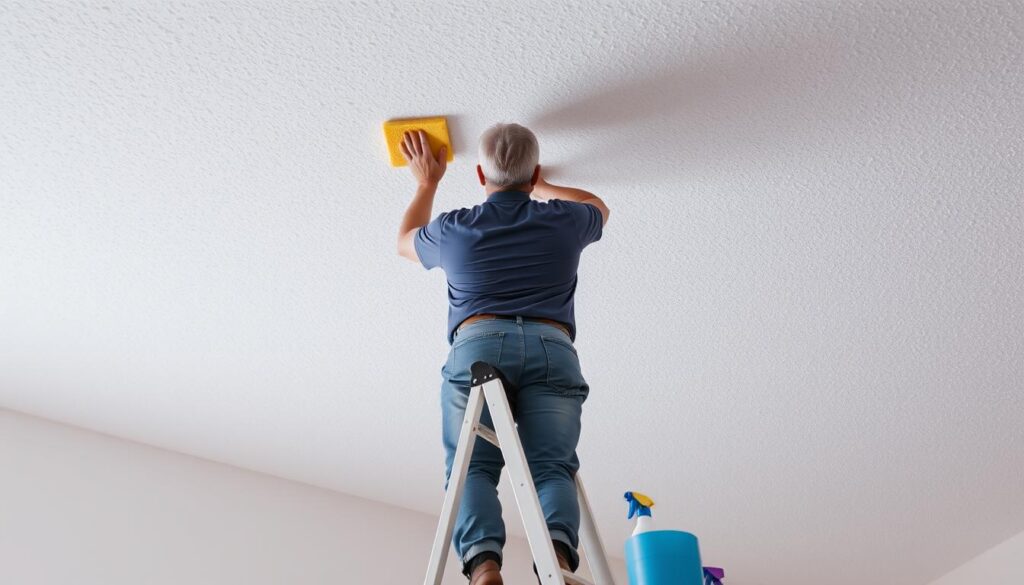
“Protecting your furniture, floors, and yourself from the dust and debris created during the cleaning process is crucial to ensure a safe and successful outcome.”
How to Dust a Popcorn Ceiling
Popcorn ceilings attract dust, cobwebs, and pollutants. It’s key to dust them yearly for a clean look. There are several ways to do this effectively.
Using a vacuum with a dusting attachment is a top choice. Move it over the ceiling in sections to avoid damaging it. This method is fast and effective for large areas.
For smaller spots or hard-to-reach areas, a long-handled feather or microfiber duster works well. These tools fit into tight spaces for a deep clean. Always use a gentle sweeping motion to protect the ceiling.
A sticky roller is also great for dusting popcorn ceilings. It quickly picks up dust and cobwebs, leaving the ceiling clean. Just roll it over the ceiling to remove dirt and debris.
- Use a vacuum with a dusting attachment for larger areas
- Employ a long-handled feather or microfiber duster for targeted cleaning
- Utilize a sticky roller to efficiently remove dust and cobwebs
Choose your method and take your time for a thorough dusting. With the right tools and effort, your ceiling will stay clean and fresh for years.
Cleaning Stains on Popcorn Ceilings
Keeping your popcorn ceiling looking great can be tough. These ceilings get stains from greasy splatters to water marks. But, with the right cleaning methods, you can make them look new again.
Types of Stains and Cleaning Solutions
The kind of stain on your ceiling will tell you how to clean it. For dirt and stains from the environment, a mix of dish soap and warm water works well. But, for tough stains like mold, mildew, or grease, you’ll need something stronger.
- Mold and mildew stains: A diluted bleach solution (1 part bleach to 3 parts water) can help eliminate these unsightly growths.
- Grease stains: A degreasing solution, such as a mixture of dish soap and warm water, can cut through the toughest kitchen splatters.
- Water stains: A 1:4 ratio of bleach to water can help remove water marks and discoloration.
Always test a cleaning solution on a small, hidden area first. This ensures it won’t harm the popcorn texture. Use a sponge to gently dab the stain, let it dry, and repeat if needed.
| Stain Type | Cleaning Solution |
|---|---|
| General dirt and environmental stains | Mild dish soap and warm water |
| Mold and mildew | Diluted bleach solution (1 part bleach to 3 parts water) |
| Grease | Degreasing solution (dish soap and warm water) |
| Water stains | Bleach solution (1 part bleach to 4 parts water) |
By using the right cleaning solutions, you can handle different stains on your popcorn ceiling. This keeps it looking its best.
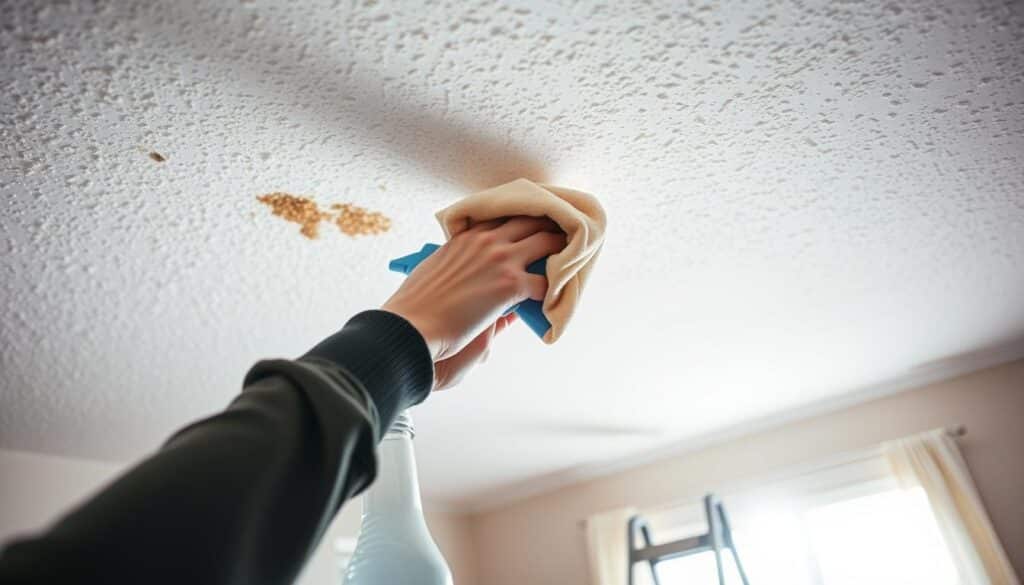
How to Remove Mold and Mildew from Popcorn Ceiling
Mold and mildew on popcorn ceilings are common, especially in humid places like bathrooms. It’s important to act fast because mold can harm your health, especially if you have breathing problems or a weak immune system. Bleach and water might work for sinks and showers, but not for popcorn ceilings.
To remove mold and mildew from popcorn ceilings, start by dusting the area. Then, mix one part bleach with four parts water in a spray bottle. Spray the solution on the mold, but don’t soak the ceiling. Too much water can damage the popcorn texture.
Let the solution sit for a few hours before dabbing the stains with a sponge. If the stains don’t go away, make a stronger bleach solution and try again. Keep doing this until the mold and mildew are gone.
Chlorine bleach might not work well on mold in textured surfaces like popcorn ceilings. Try vinegar, baking soda, or hydrogen peroxide instead. If the mold covers more than 3 square feet or you’re worried about your health, get a professional mold remover.
To stop mold and mildew on popcorn ceilings, improve ventilation and use dehumidifiers. Painting with mildew-resistant paint also helps. Fixing the moisture problem keeps your home clean and healthy.
| Mold Removal Tip | Recommendation |
|---|---|
| Cleaning Solution | Bleach-based solution (1 part bleach to 4 parts water) |
| Application | Mist affected areas, avoid oversaturation |
| Dwell Time | Allow solution to sit for a few hours |
| Agitation | Gently dab stained areas with a sponge |
| Repeat if Necessary | Use a stronger bleach solution if stains persist |
When removing mold and mildew from popcorn ceilings, always wear protective gear. Use goggles, a respirator, and gloves to keep yourself safe. By following these steps and staying safe, you can get rid of mold and mildew on your ceiling.
Removing Water Stains from Popcorn Ceilings
Water stains on popcorn ceilings are not just ugly; they can also cause mold and mildew. But, you can remove them and make your ceiling look new again.
First, find and fix the moisture problem. This might mean fixing a leaky pipe or sealing a crack. Once the moisture source is gone, you can start on the stains.
Make a solution of one part bleach to three parts water in a spray bottle. Spray the stained area lightly. Then, use a sponge to gently dab the stain. If it doesn’t go away, try a 50/50 bleach-to-water mix and dab again.
After everything is dry, check if the stains are gone. If not, prime and paint the area. This will cover up the stains and prevent new ones.
When cleaning water stains on popcorn ceiling, always wear gloves and work in a well-ventilated area. Ceilings from before 1990 might have asbestos, so test them first.
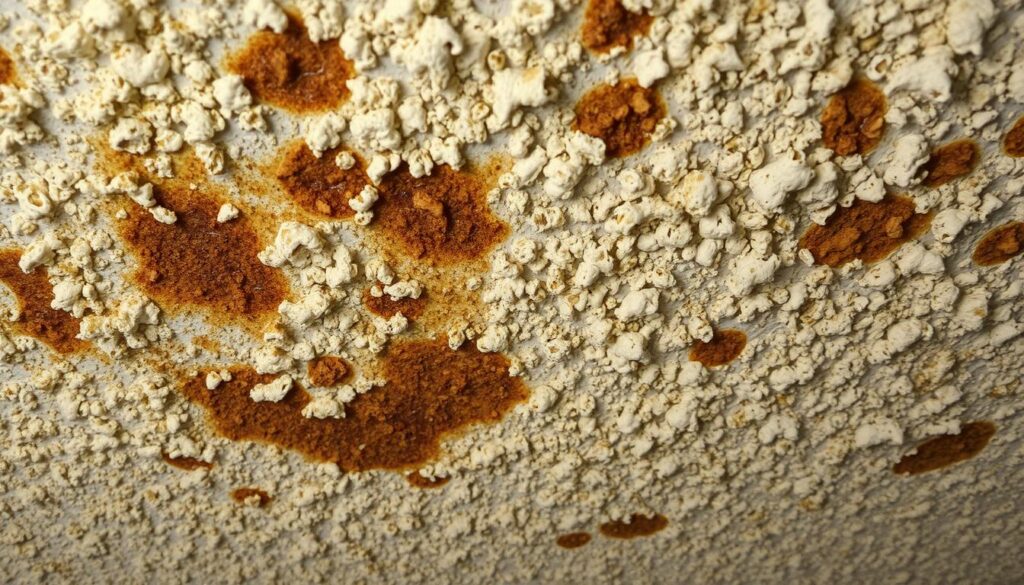
With the right steps and patience, you can get rid of water stains on popcorn ceiling. Fix the moisture problem and clean right, and your ceiling will look great again.
Painting Over Popcorn Ceilings
If your popcorn ceiling has stubborn stains or discoloration, painting can be a great fix. But, painting it needs extra care for a smooth finish.
Use a thick-nap roller made for textured surfaces to paint your ceiling. This roller ensures even coverage and keeps the popcorn material in place. Start with a stain-blocking primer followed by high-quality latex paint.
Paint in small sections with light, even strokes. This avoids damaging the texture. You might need to apply multiple coats for full coverage. Be patient and take your time to avoid an uneven look.
“Painting a popcorn ceiling can be a great way to refresh the look of your space, but it requires a bit of extra care and attention to get the job done right.”
Success in painting a popcorn ceiling comes from using the right tools and taking your time. With effort, you can change your room’s look and enjoy a new ceiling.
Maintaining Clean Popcorn Ceilings
To keep your popcorn ceiling looking great, you need to act early. Dusting it at least once a year can stop dirt and pollutants from staining it. Fixing stains or moisture quickly is key to avoid mold and damage.
Popcorn ceilings were common from the 1950s to the 1980s. But, they catch dust and spider webs easily. Always test cleaning methods on a small, hidden spot first to avoid damage.
Clean your popcorn ceiling in small sections, about 4×4 feet. Make sure you have good ventilation to avoid inhaling fumes. For light cleaning, use a vacuum with a soft brush. For deeper cleaning, try damp sponges or solutions like vinegar, fabric softener, or hydrogen peroxide.
Be careful, especially with ceilings before 1980, as they might have asbestos. Always wear protective goggles and gloves when using chemicals.
By cleaning and maintaining your popcorn ceiling well, you can make it last longer. Regular cleaning, fixing stains fast, and watching for mold or moisture will help you maintain your popcorn ceiling and keep it clean regularly.
“Cleaning a popcorn ceiling is like a dance – you need to be light on your feet, but also persistent in your movements to keep it looking fresh and inviting.”
When to Call a Professional
While cleaning popcorn ceilings can be fun, there are times when you should call a pro. If your ceiling has asbestos, which was used before 1978, it’s important to test and remove it. A licensed asbestos abatement contractor should do this. Asbestos can be very harmful, so it’s not something to mess with.
Also, if your ceiling’s popcorn texture is badly damaged or the ceiling is in bad shape, a pro might be a better choice. They can fix it without making things worse. The wrong cleaning can make the popcorn texture crumble or flake, which is hard and expensive to fix.
Lastly, if you’re scared of heights or don’t know how to clean it right, get a pro. Cleaning popcorn ceilings can be tricky. A professional has the right tools and knows how to do it correctly the first time.
| Scenario | Recommended Action |
|---|---|
| Ceiling contains asbestos | Hire a licensed asbestos abatement contractor |
| Severely damaged popcorn texture | Hire a professional popcorn ceiling cleaning service |
| Uncomfortable working at heights | Hire a professional cleaning service |
Knowing when to call a pro for popcorn ceiling cleaning helps keep your home safe and in good shape. It ensures the job is done right without causing more damage.
Alternatives to Popcorn Ceilings
If you want to update your home, there are many options besides popcorn ceilings. These modern choices not only look fresh but are also easier to keep clean than popcorn ceilings.
Smooth drywall ceilings are a popular pick. They give a clean look that makes rooms seem bigger. Textured or knockdown finishes are also great, offering a modern yet subtle vibe.
Decorative ceiling tiles or panels add a unique flair. They come in many materials, patterns, and designs. These alternatives are also more water-resistant and simple to clean than popcorn ceilings.
When picking a popcorn ceiling replacement, think about your budget, style, and upkeep needs. Talking to a pro can guide you to the perfect fit for your home and life.
| Alternative | Key Features | Advantages |
|---|---|---|
| Smooth Drywall Ceiling | Clean, seamless look | Creates illusion of higher ceilings, easy to maintain |
| Textured or Knockdown Finish | Subtle, contemporary appearance | Visually appealing, more durable than popcorn |
| Decorative Ceiling Tiles or Panels | Wide range of materials, patterns, and designs | Personalized look, water-resistant, easy to clean |
Exploring alternatives to popcorn ceilings can upgrade your home’s look and simplify upkeep. Whether you opt for smooth, textured, or decorative, these alternatives to replace popcorn ceiling offer a modern, easy-care solution.
Conclusion
Popcorn ceilings were once a favorite, but they need regular cleaning to avoid dust and stains. By following this guide, I can safely clean my ceiling. This makes it look fresh and clean again.
It’s important to be careful and protect my furniture and floors. I also need to use the right cleaning solutions for each stain. This ensures my ceiling stays in great shape.
Keeping my popcorn ceiling clean is easy with a little effort. Regular dusting and quick stain fixes are key. This way, my ceiling stays healthy and my home looks good.
By following the tips in this article, I can keep my popcorn ceiling clean for years. This helps maintain my home’s value and keeps it comfortable.
Staying on top of maintenance is crucial for a clean popcorn ceiling. By addressing problems quickly, I protect my home’s value. With the right care, my ceiling will stay beautiful and functional.
FAQ
What are the safety precautions to take when cleaning a popcorn ceiling?
Before you start cleaning a popcorn ceiling, make sure you’re safe. If your home was built before 1978, it might have asbestos. This is a dangerous substance. You should have it checked and removed by experts if it’s found.
Once it’s safe, get your cleaning gear ready. You’ll need plastic sheets, a dust mask, goggles, gloves, and a vacuum or duster.
How do I dust a popcorn ceiling?
Dusting a popcorn ceiling can be done in a few ways. You can use a vacuum, a feather or microfiber duster, or a sticky roller. Vacuuming works well, especially with a brush attachment.
For small spots or hard-to-reach areas, a long duster is great. A sticky roller is quick for dust and cobwebs all over.
How do I remove mold and mildew from a popcorn ceiling?
To get rid of mold and mildew, start by dusting the ceiling. Then, mix bleach and water in a spray bottle. Spray the moldy spots carefully to avoid too much water.
Let it sit for a few hours. Then, gently wipe the spots with a sponge. If it’s still there, use a stronger solution and try again.
How do I remove water stains from a popcorn ceiling?
To fix water stains, first find and fix the moisture source. Then, mix bleach and water in a spray bottle. Spray the stain and wipe it with a sponge.
Let it dry and if it’s still there, use a stronger solution. If it doesn’t go away, you might need to prime and paint the area.
Can I paint a popcorn ceiling?
Yes, painting a popcorn ceiling can make it look new. Use a special roller for textured surfaces. Apply a primer first, then paint.
Work in small areas and use light strokes to avoid damaging the ceiling. You might need to paint it multiple times for the best look.
When should I call a professional to clean my popcorn ceiling?
While you can clean a popcorn ceiling yourself, there are times when a pro is better. If it has asbestos, you need a licensed contractor to remove it.
If the ceiling is badly damaged or you’re not comfortable with heights, a pro can help. They can clean it safely and effectively.


